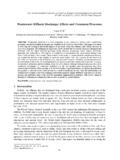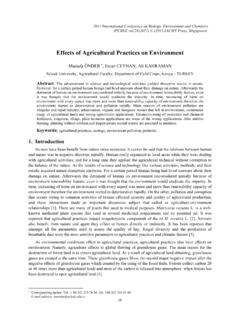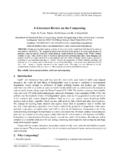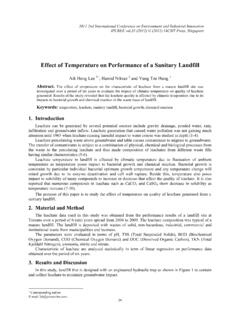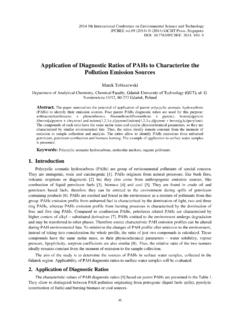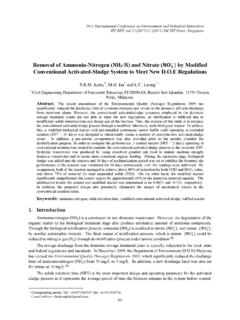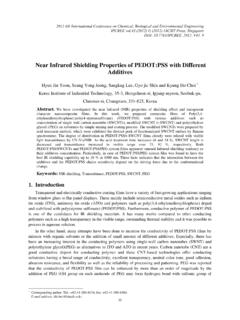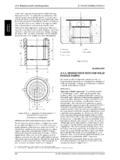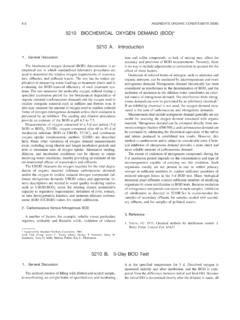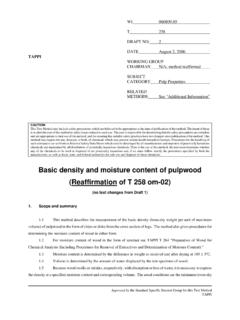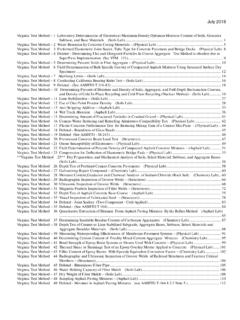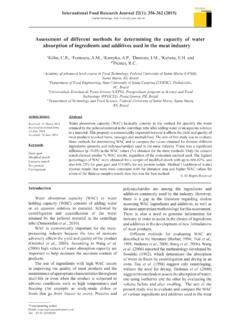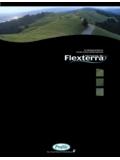Transcription of Determination of Yogurt Quality by Using …
1 2013 2nd International Conference on Nutrition and Food Sciences IPCBEE (2013) (2013) IACSIT Press, Singapore DOI: 2013. V53. 23. Determination of Yogurt Quality by Using rheological and textural parameters Tulay Ozcan . Uludag University, Department of Food Engineering, 16059 Gorukle, Bursa, TURKEY. Abstract. Sensory and textural parameters of Yogurt are known to have an important impact on food Quality and acceptability. The emphasis in this article is to summarize the rheological and textural parameters of Yogurt . Viscosity, hardness, adhesiveness, cohesiveness, and springiness are considered the most important descriptors for the textural perception of Yogurt . Factors affecting textural properties of Yogurt and the possible defects are also discussed in this paper.
2 Keywords: Yogurt , rheology, texture 1. Introduction Yogurt is a very popular functional dairy product which is produced by acid fermentation of milk with the thermophilic homofermentative lactic acid bacteria Streptococcus thermophilus and Lactobacillus delbrueckii ssp. bulgaricus. The manufacturing processes of Yogurt differ depending on the country, but it always comprises a lactic fermentation that brings milk to gelification due to destabilization of the protein system. It is normally retailed in one of the three physical states, namely set (undisturbed gel in the retail pot), stirred (the acid gel formed during incubation in large fermentation tanks is disrupted by stirring) or fluid (drinking yoghurt). Most of the basic plain yogurts are set yogurts, which are fermented in the container that they are eventually sold in, while most fruit-flavored yogurts are stirred yogurts, because flavors and fruit added after fermentation need to be properly dispersed in the Yogurt matrix (Tamime and Robinson, 1999.)
3 Chandan, 2006; Tamime 2006). 2. rheological and textural parameters of Yogurt Texture is one of the most essential components of Yogurt Quality . Texture, which comes from Latin textura (cloth), is a vocable used initially to describe the cross-linking style of weave threads. It now defines disposition and arrangement for the different parts of a system. For food products, according to the International Standard Organization, texture represents all the rheological and structural attributes perceptible by means of mechanical, tactile, and, when appropriate, visual and auditory receptors. Rheology and structure of a product evaluated by instrumental methods also give relevant information on its textural properties (Ramaswamy and Basak, 1991; Borwankar, 1992; Foegeding et al.
4 2011; Fisher and Windhad, 2011). The texture of Yogurt or any type of fermented milk product is important with regard to the Quality of the products. It is related to sensory perception of food product. The textural characteristics of Yogurt are generally studied in the cup, Using a spoon, or in the mouth by sensory methods. The most common sensory attributes relating to Yogurt texture are thickness /viscosity, smoothness (opposite to lumpiness, graininess, grittiness), and sliminess (or ropiness). Determination of the Yogurt texture usually includes sensory, . Corresponding author. Tel.: +90 224 294 1498; Fax: +90 224 294 1402. E-mail address: 118. structure and rheology analyses (Sodini et al. 2004; Walstra et al. 2006). Generally textural properties of Yogurt can be assessed following methods: Instrumental Analysis: Rheology and Texture - Small-amplitude oscillatory rheology (SAOR).
5 - Large-amplitude oscillatory shear - Penetrometry - Texture profile analysis - Viscometry Instrumental Analysis: Structure - Visual observation of gel microstructure and indirect evaluation of network homogeneity by measurements of water-holding capacity (WHC). - Scanning or transmission electron microscopy - Confocal scanning laser microscopy - Permeability of drainage test Sensory Analysis - Smoothness: lumpiness, graininess, grittiness; sliminess or ropiness rheological Methods Food rheology is the study of deformation and flow of food materials. Milk gels are visco-elastic, thus Yogurt 's rheological properties can be characterized Using both the viscous and elastic components. Visco- elastic indicates that the material has some of the elastic properties of an ideal solid and some of the flow properties of an ideal (viscous) liquid (Steffe, 1996; Rao, 1999; Lee and Lucey, 2010).
6 Small Amplitude Oscillatory Rheology Small amplitude oscillatory rheology (SAOR) has been used to characterize the rheological properties of Yogurt during the gel formation process (fermentation) without damaging the weak gel network. Small deformation is defined as a small relative deformation (strain or change in dimension) ( 1%), when its applied it does not disrupt the development of the network structure. SAOR testing involves applying an oscillatory (sinusoidal) stress/strain and measuring the strain/stress responses (Ross-Murphy, 1995; Steffe, 1996; Rao, 1999; Lee and Lucey, 2010). The following rheological parameters determined in a SAOR test. Elastic or storage modulus (G ) expresses the measure of energy stored per deformation cycle and indicates the solid-like properties.
7 Viscous or loss modulus (G ) indicates the magnitude of energy lost as viscous dissipation per cycle of deformation and reflects the liquid-like properties. Loss tangent (LT) is defined as ratio of loss modulus to storage modulus (G /G ) and indicates the type of visco-elastic properties in a material. In simple terms G represents the elasticity whereas G indicates the viscous or liquid character of the gel network. A high LT value ( , G >G ) means that the material has liquid-like behavior. Large Deformation Rheology Large deformation characteristics of food gels are related to functional properties including shaping, cutting/slicing and eating characteristics (van Vliet and Walstra, 1995). rheological parameters that can be obtained from this type of test include yield stress ( yield) and yield strain ( yield), which are defined as the point when the shear stress begins to decrease.
8 A low yield value implies that the Yogurt gel has weak network, while a low value of yield implies that it is a brittle or short textured gel. The strength of protein- protein bonds, the number of bonds per cross-section of the strand, relaxation times for the network bonds, and the orientation of strands in the matrix all contribute to the yield properties of gels (Steffe, 1996; Lucey et ; Ozcan et al. 2011). Texture Profile Analysis (TPA). Some textural parameters are determined by Using Texture Profile Analysis (TPA) with mechanical compression of a food. All TPA measurements are carried out with two-cycle uniaxial compression 119. instruments (Fig. 1). Classification of food texture into primary, secondary or tertiary characteristics are summarized in Fig.
9 2. (Sherman 1969; Chen and Stokes 2012). Force Pre-test speed Compression probe Sample Time TA-XT2 Texture Analyzer Set Up Typical Texture Expert Curve Fig. 1. Uniaxial compression test of sample during texture profile analysis visual appearance Initial perception sampling and slicing characteristic (before placing in mouth) spreading, creaming characteristic, pourability analytical characteristic Primary characteristic particle size, shape and size distribution Initial perception on palate oil content; size, shape and size distribution of oil particle elasticity, cohesion Secondary characteristic viscosity adhesion (to palate). hard, soft Mastication Tertiary characteristic brittle, plastic, crisp, rubbery, spongy (high shearing stress) smooth, coarse, powdery, lumpy, pasty creamy, watery, soggy sticky, tacky greasy, gummy, stringy Residual masticatory melt down properties on palate impression Fig.
10 2. Classification of food texture into primary, secondary or tertiary characteristics Texture profile measurements are originally carried out Using double-bite compression tests (Fig. 3). In practice, force (stress) and deformation (strain) are the two fundamental parameters for texture characterization. TPA measures parameters such as chewiness, gumminess, cohesiveness, adhesiveness and firmness (Bourne 1978; Chen and Stokes 2012). The peak force during the first compression cycle is defined as hardness or firmness. The ratio of the positive force area during the second compression cycle to that during the first compression cycle (area 2/area 1) is originally defined as cohesiveness. The negative force area of the first compression cycle (area 3), adhesiveness.
